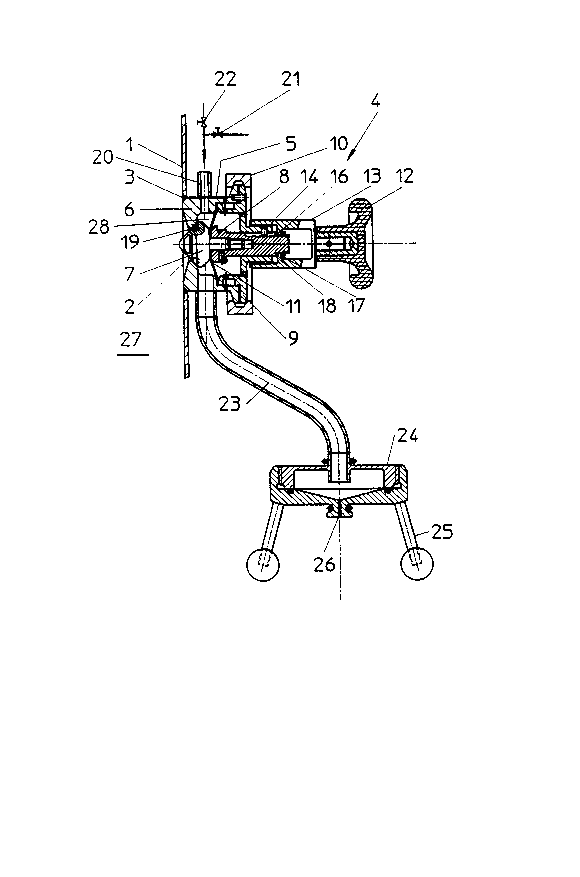Some of the information on this Web page has been provided by external sources. The Government of Canada is not responsible for the accuracy, reliability or currency of the information supplied by external sources. Users wishing to rely upon this information should consult directly with the source of the information. Content provided by external sources is not subject to official languages, privacy and accessibility requirements.
Any discrepancies in the text and image of the Claims and Abstract are due to differing posting times. Text of the Claims and Abstract are posted:
| (12) Patent Application: | (11) CA 2064450 |
|---|---|
| (54) English Title: | DEVICE FOR TAKING ASEPTIC SAMPLES OF PRODUCTS |
| (54) French Title: | DISPOSITIF SERVANT A PRELEVER DES ECHANTILLONS ASEPTIQUES DE DIFFERENTS PRODUITS |
| Status: | Deemed Abandoned and Beyond the Period of Reinstatement - Pending Response to Notice of Disregarded Communication |
| (51) International Patent Classification (IPC): |
|
|---|---|
| (72) Inventors : |
|
| (73) Owners : |
|
| (71) Applicants : |
|
| (74) Agent: | BORDEN LADNER GERVAIS LLP |
| (74) Associate agent: | |
| (45) Issued: | |
| (22) Filed Date: | 1992-03-30 |
| (41) Open to Public Inspection: | 1992-10-25 |
| Availability of licence: | N/A |
| Dedicated to the Public: | N/A |
| (25) Language of filing: | English |
| Patent Cooperation Treaty (PCT): | No |
|---|
| (30) Application Priority Data: | ||||||
|---|---|---|---|---|---|---|
|
- 6 -
ABSTRACT:
A device for taking aseptic samples of products
The device comprises a valve (4) for drawing off products,
an inlet pipe (20) for steam and sterile air and a product
sampling pipe (23), in which the draw-off valve comprises
a closure cone (7) which, in the closed position, rests
on a valve seat (6), the plane of contact of the cone
with the seat being situated substantially level with
the surface of the enclosure, the steam inlet pipe opens
directly into the head space of the valve and the product
sampling pipe is in the extension of the steam inlet pipe.
Fig.1
Note: Claims are shown in the official language in which they were submitted.
Note: Descriptions are shown in the official language in which they were submitted.

2024-08-01:As part of the Next Generation Patents (NGP) transition, the Canadian Patents Database (CPD) now contains a more detailed Event History, which replicates the Event Log of our new back-office solution.
Please note that "Inactive:" events refers to events no longer in use in our new back-office solution.
For a clearer understanding of the status of the application/patent presented on this page, the site Disclaimer , as well as the definitions for Patent , Event History , Maintenance Fee and Payment History should be consulted.
| Description | Date |
|---|---|
| Inactive: IPC from MCD | 2006-03-11 |
| Inactive: IPC from MCD | 2006-03-11 |
| Time Limit for Reversal Expired | 2000-03-30 |
| Application Not Reinstated by Deadline | 2000-03-30 |
| Deemed Abandoned - Failure to Respond to Maintenance Fee Notice | 1999-03-30 |
| Inactive: Abandon-RFE+Late fee unpaid-Correspondence sent | 1999-03-30 |
| Application Published (Open to Public Inspection) | 1992-10-25 |
| Abandonment Date | Reason | Reinstatement Date |
|---|---|---|
| 1999-03-30 |
The last payment was received on 1998-02-19
Note : If the full payment has not been received on or before the date indicated, a further fee may be required which may be one of the following
Please refer to the CIPO Patent Fees web page to see all current fee amounts.
| Fee Type | Anniversary Year | Due Date | Paid Date |
|---|---|---|---|
| MF (application, 6th anniv.) - standard | 06 | 1998-03-30 | 1998-02-19 |
Note: Records showing the ownership history in alphabetical order.
| Current Owners on Record |
|---|
| SOCIETE DES PRODUITS NESTLE S.A. |
| Past Owners on Record |
|---|
| RUDOLF SCHMIED |
| WILLY HUGELSHOFER |